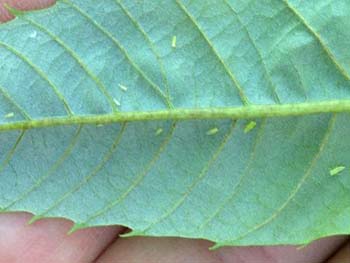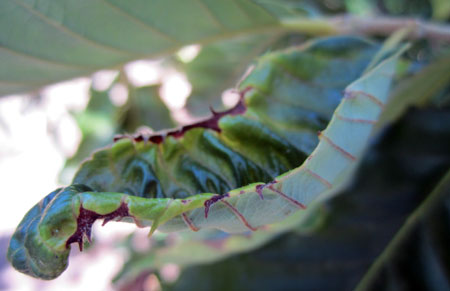Michigan chestnut update — May 23, 2018
Chestnut trees have broken bud, even in the far north regions of Michigan. Potato leafhopper have arrived in southern Michigan.

Chestnut trees around Michigan are starting to push leaves. Leaf emergence in southern Michigan is well-ahead of northern locations where buds just broke for many cultivars last week. Reports of sporadic winter injury are coming in.
Early herbicide applications were really effective this season. Fieldwork has been difficult in areas of southern Michigan that received excessive rainfall earlier this month. Remove mouse guards off of young trees to prevent girdling and bark damage. Reapply mouse guards this fall to prevent rodent and rabbit damage to small diameter trees over the winter.
Grower cooperators around the state have begun monitoring for chestnut weevil this spring, thus far no weevils have been caught. No formal research has been done on the lifecycle of this pest in Michigan, however, based on research out of Kentucky and Missouri, it is possible that lesser chestnut weevil may begin moving into orchards around bloom. A number of orchards experienced heavy weevil infestations in 2017. Trapping this year should help Michigan growers better understand the behavior of weevils in Michigan. To learn more about chestnut weevils, visit Michigan State University Extension’s page on Potential and Emerging Pests in Chestnuts. Special thanks to our grower cooperators!
Potato leafhopper has arrived in southern Michigan and growers around the state should be scouting at this time. Potato leafhoppers can’t survive Michigan’s winter and survive in the Gulf States until adults migrate north in the spring on storm systems. Like many plants, chestnuts are sensitive to the saliva of potato leafhoppers, which is injected by the insect while feeding. Damage to leaf tissue can cause reduced photosynthesis, which can impact production and quality, and damage the tree.
Symptoms of feeding appear as whitish dots arranged in triangular shapes near the edges. Heavily-damaged leaves are cupped with necrotic and chlorotic edges and eventually fall from the tree. Adult leafhoppers are pale to bright green and about 1/8-inch long. Adults are easily noticeable, jumping, flying or running when agitated. Most growers utilize neonicotinoid insecticides when treatment is warranted. Read more about potato leafhoppers from MSU Extension.


Left/top: Immature potato leafhopper on the underside of a chestnut leaf. Right/bottom: Potato leafhopper feeding damage to chestnut causing leaf cupping and necrotic margins.
Josh Springer, president of the Midwest Nut Producers Council, is collecting information for the annual tree mortality survey—please contact him at cryphonectria@gmail.com if you are a Michigan grower and have not yet received a request to complete the survey.
Save the dates
Aug. 11 – The MSU Chestnut Research Program and the Ernie and Mabel Rogers Research Endowment are sponsoring an educational session at Rogers Reserve in Jackson, Michigan. The program will focus on applying pest management strategies in the orchard and in the processing facility: managing brown rot of chestnut, chestnut weevils, Asian chestnut gall wasp and Phytophthora root rot. Stay tuned for more information soon.
Aug. 25 – MSU Extension and the Midwest Nut Producers Council will be hosting a Summer Farm Tour and Fundraiser in west central Michigan. Details to follow!
Stay in touch
Want to receive more pest management information for chestnut this season? Sign up to receive the MSU Extension News for Chestnuts Digest or follow us on Facebook at MSU Chestnut News.
This work is supported by the Crop Protection and Pest Management Program 2017-70006-27175 from the USDA National Institute of Food and Agriculture. Any opinions, findings, conclusions or recommendations expressed in this publication are those of the author(s) and do not necessarily reflect the view of the U.S. Department of Agriculture.



 Print
Print Email
Email



